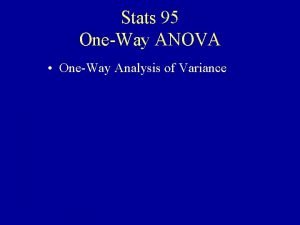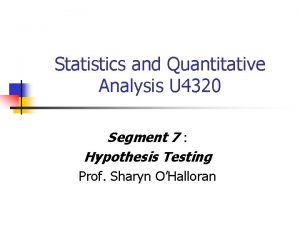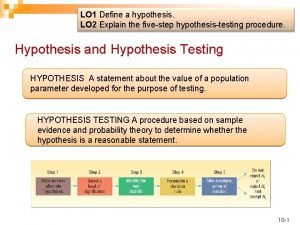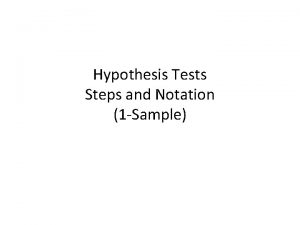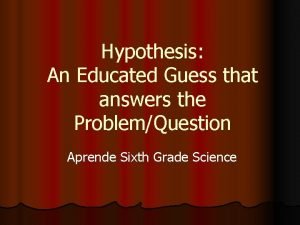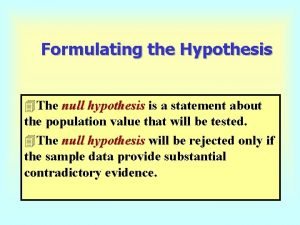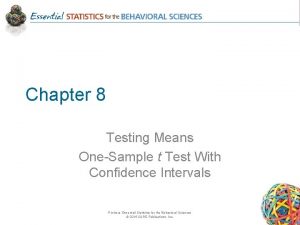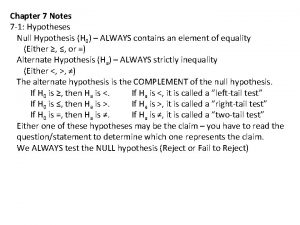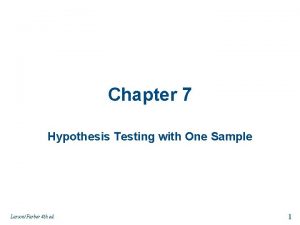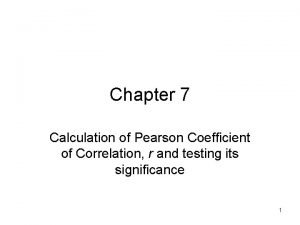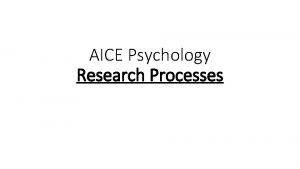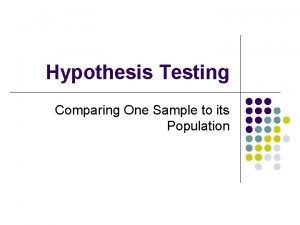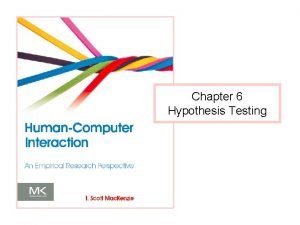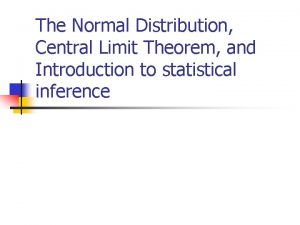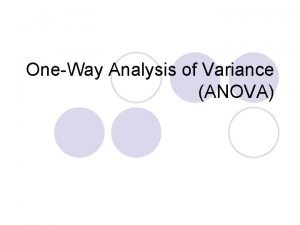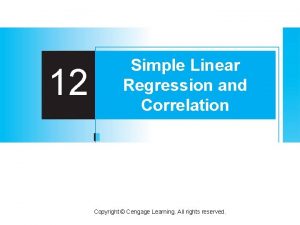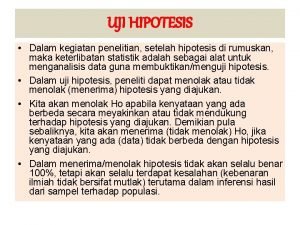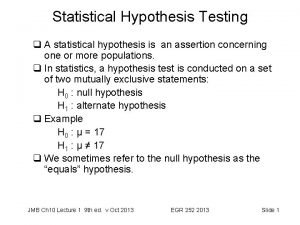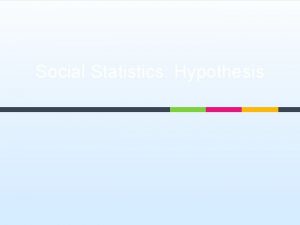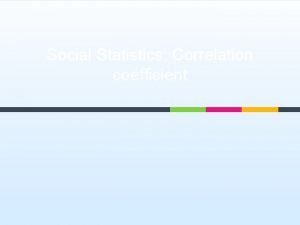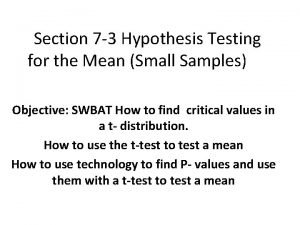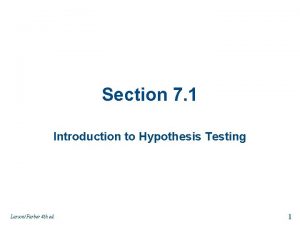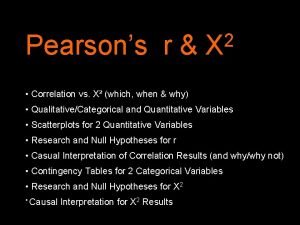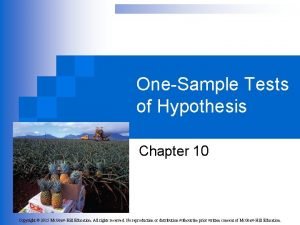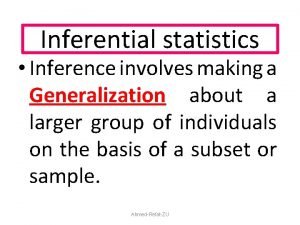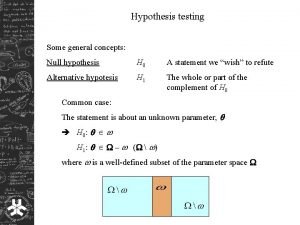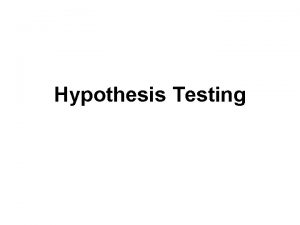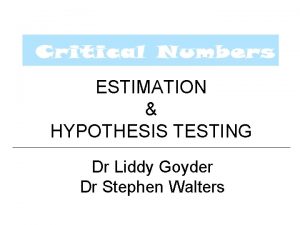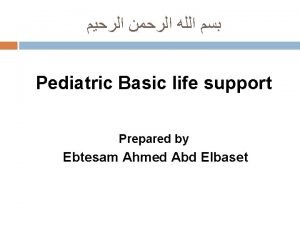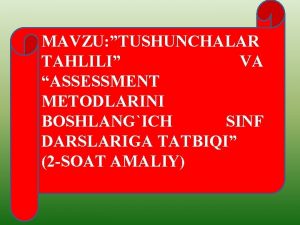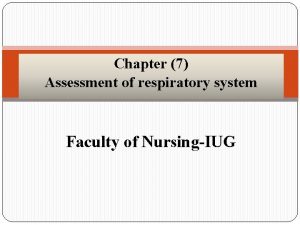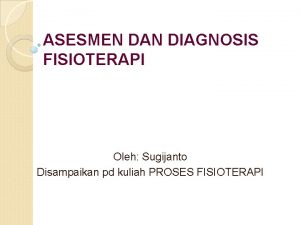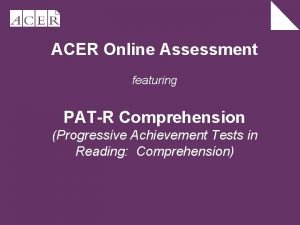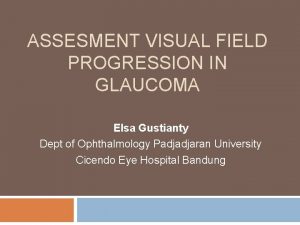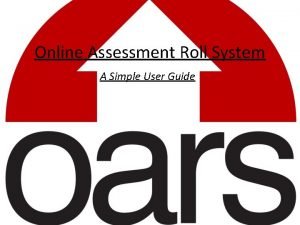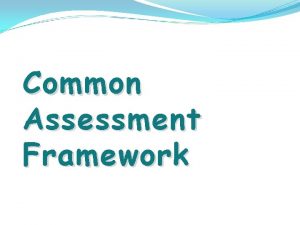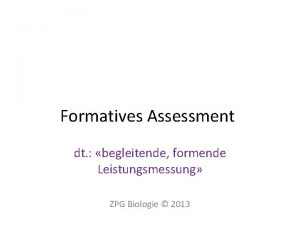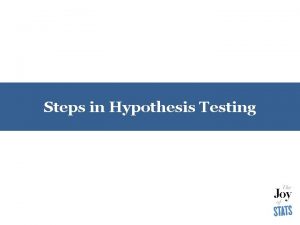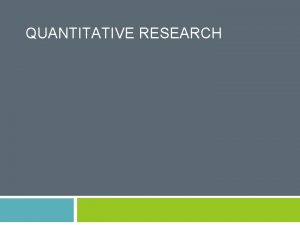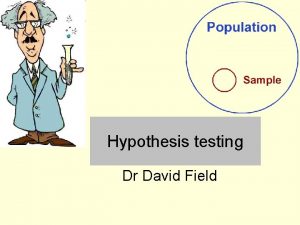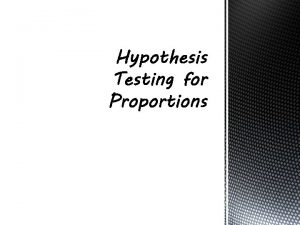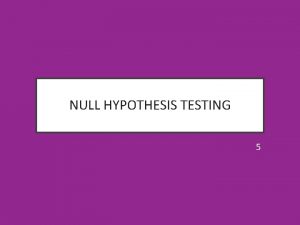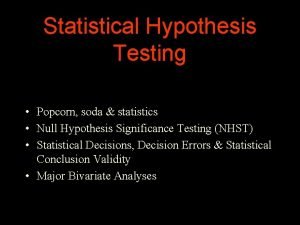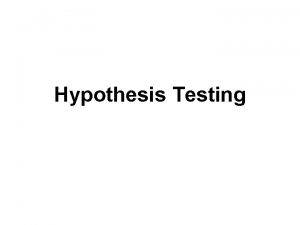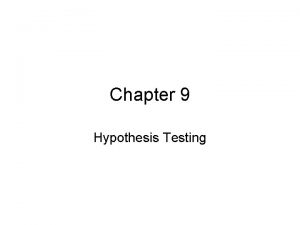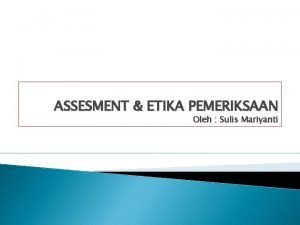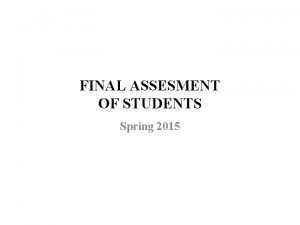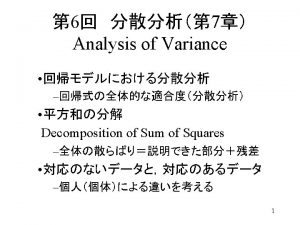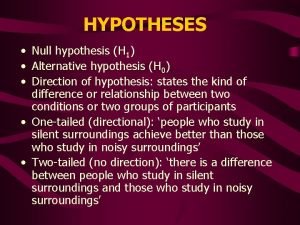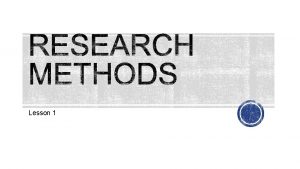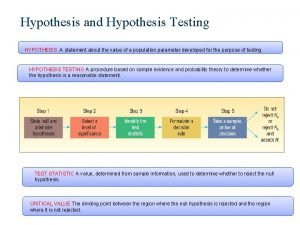SUMMARY Hypothesis testing Selfengagement assesment Null hypothesis song





















































- Slides: 53

SUMMARY Hypothesis testing

Self-engagement assesment

Null hypothesis song Null hypothesis: I assume that populations without and with song are same. At the beginning of our calculations, we assume the null hypothesis is true. no song

Hypothesis testing song • Because of such a low probability, we interpret 8. 2 as a significant increase over 7. 8 caused by undeniable pedagogical qualities of the 'Hypothesis testing song'. 7. 8 8. 2

Four steps of hypothesis testing 1. Formulate the null and the alternative (this includes one- or two-directional test) hypothesis. 2. Select the significance level α – a criterion upon which we decide that the claim being tested is true or not. --- COLLECT DATA --3. Compute the p-value. The p-value is the probability that the data would be at least as extreme as those observed, if the null hypothesis were true. 4. Compare the p-value to the α-level. If p ≤ α, the observed effect is statistically significant, the null is rejected, and the alternative hypothesis is valid.

One-tailed and two-tailed one-tailed (directional) test two-tailed (non-directional) test Z-critical value, what is it?

NEW STUFF

Decision errors • Hypothesis testing is prone to misinterpretations. • It's possible that students selected for the musical lesson were already more engaged. • And we wrongly attributed high engagement score to the song. • Of course, it's unlikely to just simply select a sample with the mean engagement of 8. 2. The probability of doing so is 0. 0022, pretty low. Thus we concluded it is unlikely. • But it's still possible to have randomly obtained a sample with such a mean.

Four possible things can happen Decision State of the world Reject H 0 Retain H 0 true 1 3 H 0 false 2 4 In which cases we made a wrong decision?

Four possible things can happen Decision Reject H 0 State of the world H 0 true H 0 false Retain H 0 1 4 In which cases we made a wrong decision?

Four possible things can happen Decision Reject H 0 State of the world H 0 true H 0 false Retain H 0 Type I error Type II error

Type I error • When there really is no difference between the populations, random sampling can lead to a difference large enough to be statistically significant. • You reject the null, but you shouldn't. • False positive – the person doesn't have the disease, but the test says it does

Type II error • When there really is a difference between the populations, random sampling can lead to a difference small enough to be not statistically significant. • You do not reject the null, but you should. • False negative - the person has the disease but the test doesn't pick it up • Type I and II errors are theoretical concepts. When you analyze your data, you don't know if the populations are identical. You only know data in your particular samples. You will never know whether you made one of these errors.

The trade-off • If you set α level to a very low value, you will make few Type I/Type II errors. • But by reducing α level you also increase the chance of Type II error.

Clinical trial for a novel drug • Drug that should treat a disease for which there exists no therapy • If the result is statistically significant, drug will me marketed. • If the result is not statistically significant, work on the drug will cease. • Type I error: treat future patients with ineffective drug • Type II error: cancel the development of a functional drug for a condition that is currently not treatable. • Which error is worse? • I would say Type II error. To reduce its risk, it makes sense to set α = 0. 10 or even higher. Harvey Motulsky, Intuitive Biostatistics

Clinical trial for a me-too drug • Drug that should treat a disease for which there already exists anotherapy • Again, if the result is statistically significant, drug will me marketed. • Again, if the result is not statistically significant, work on the drug will cease. • Type I error: treat future patients with ineffective drug • Type II error: cancel the development of a functional drug for a condition that can be treated adequately with existing drugs. • Thinking scientifically (not commercially) I would minimize the risk of Type I error (set α to a very low value). Harvey Motulsky, Intuitive Biostatistics

Engagement example, n = 30 • Z = 1. 87 Z = 0. 79 www. udacity. com – Statistics

Engagement example, n = 30 Which of these four quadrants represent the result of our hypothesis test? Decision Reject H 0 State of the world Retain H 0 true H 0 false www. udacity. com – Statistics

Engagement example, n = 30 Which of these four quadrants represent the result of our hypothesis test? Decision Reject H 0 State of the world H 0 true H 0 false Retain H 0 X

Engagement example, n = 50 • Z = 2. 42 Z = 1. 02 www. udacity. com – Statistics

Engagement example, n = 50 Which of these four quadrants represent the result of our hypothesis test? Decision Reject H 0 State of the world Retain H 0 true H 0 false www. udacity. com – Statistics

Engagement example, n = 50 Which of these four quadrants represent the result of our hypothesis test? Decision Reject H 0 State of the world H 0 true Retain H 0 X H 0 false www. udacity. com – Statistics

population of students that did not attend the musical lesson parameters are known population of students that did attend the musical lesson sample statistic is known

Test statistic test statistic Z-test

New situation • An average engagement score in the population of 100 students is 7. 5. • A sample of 50 students was exposed to the musical lesson. Their engagement score became 7. 72 with the s. d. of 0. 6. • DECISION: Does a musical performance lead to the change in the students' engagement? Answer YES/NO. • Setup a hypothesis test, please.

Hypothesis test •

Formulate the test statistic population of students that did not attend the musical lesson known unknown but this is unknown! • population of students that did attend the musical lesson sample

t-statistic • one sample t-test jednovýběrový t-test

t-distribution

One-sample t-test •

Quiz •

Z-test vs. t-test •

Typical example of one-sample t-test •

Dependent t-test for paired samples • Two samples are dependent when the same subject takes the test twice. • paired t-test (párový t-test) • This is a two-sample test, as we work with two samples. • Examples of such situations: • Each subject is assigned to two different conditions (e. g. , use QWERTZ keyboard and AZERTY keyboard and compare the error rate). • Pre-test … post-test. • Growth over time.

Example • student 1 student 2 student n song no song

Do the hypothesis test •

Do the hypothesis test •

Dependent samples • e. g. , give one person two different conditions to see how he/she reacts. Maybe one control and one treatment or two types of treatments. • Advantages • we can use fewer subjects • cost-effective • less time-consuming • Disadvantages • carry-over effects • order may influence results

Independent samples •

Independent samples • This is true only if two samples are independent!

Independent samples •

An example •

An example •

An example •

Summary of t-tests • two-sample tests

F-test of equality of variances • source: Wikipedia

t-test in R • t. test() • Let's have a look into R manual: http: //stat. ethz. ch/R-manual/R-patched/library/stats/html/t. test. html • See my website for link to pdf explaining various t-test in R (with examples).

Assumptions 1. Unpaired t-tests are highly sensitive to the violation of the independence assumption. 2. Populations samples come from should be approximately normal. • This is less important for large sample sizes. • What to do if these assumptions are not fullfilled 1. Use paired t-test 2. Let's see further

Check for normality – histogram

Check for normality – QQ-plot qqnorm(rivers) qqline(rivers)

Check for normality – tests • The graphical methods for checking data normality still leave much to your own interpretation. If you show any of these plots to ten different statisticians, you can get ten different answers. • H 0: Data follow a normal distribution. • Shapiro-Wilk test • shapiro. test(rivers): Shapiro-Wilk normality test data: rivers W = 0. 6666, p-value < 2. 2 e-16

Nonparametric statistics • Small samples from considerably non-normal distributions. • non-parametric tests • No assumption about the shape of the distribution. • No assumption about the parameters of the distribution (thus they are called non-parametric). • Simple to do, however their theory is extremely complicated. Of course, we won't cover it at all. • However, they are less accurate than their parametric counterparts. • So if your data fullfill the assumptions about normality, use paramatric tests (t-test, F-test).

Nonparametric tests • If the normality assumption of the t-test is violated, and the sample sizes are too small, then its nonparametric alternative should be used. • The nonparametric alternative of t-test is Wilcoxon test. • wilcox. test() • http: //stat. ethz. ch/R-manual/R-patched/library/stats/html/wilcox. test. html
 Hypothesis in quantitative research
Hypothesis in quantitative research Null and alternative hypothesis statistics
Null and alternative hypothesis statistics Null hypothesis
Null hypothesis One way anova null hypothesis
One way anova null hypothesis How to find t critical value
How to find t critical value What is a directional hypothesis in psychology
What is a directional hypothesis in psychology One-way anova hypothesis testing
One-way anova hypothesis testing Standard deviation null hypothesis
Standard deviation null hypothesis Hypothesis paragraph example
Hypothesis paragraph example Assumptions of hypothesis testing
Assumptions of hypothesis testing The null hypothesis is an educated guess answer
The null hypothesis is an educated guess answer Null hypothesis statistics
Null hypothesis statistics Critical chi square value
Critical chi square value One sample t test formula
One sample t test formula Null hypothesis example
Null hypothesis example Null hypothesis symbol
Null hypothesis symbol Null and alternative hypothesis for correlation
Null and alternative hypothesis for correlation What's a null hypothesis in psychology
What's a null hypothesis in psychology Hypothesis test statistics formula
Hypothesis test statistics formula Ap biology null hypothesis
Ap biology null hypothesis Mann whitney null hypothesis
Mann whitney null hypothesis North dakota null hypothesis brain inventory
North dakota null hypothesis brain inventory Central limit theorem standard error
Central limit theorem standard error Steps in hypothesis testing ppt
Steps in hypothesis testing ppt One way anova null hypothesis
One way anova null hypothesis Copyright
Copyright Hipotesis nol adalah
Hipotesis nol adalah Null hypothesis example
Null hypothesis example Null hypothesis
Null hypothesis T-test for correlation
T-test for correlation Statistics critical value
Statistics critical value Alternative hypothesis
Alternative hypothesis Pearsons r
Pearsons r Examples of hypothesis
Examples of hypothesis What is an alternative hypothesis
What is an alternative hypothesis What is null hypothesis
What is null hypothesis Alternative hypothesis
Alternative hypothesis Null hypothesis example
Null hypothesis example Pat pediatric assessment
Pat pediatric assessment Assesment in lesson plan
Assesment in lesson plan Chaynvord metodi
Chaynvord metodi It assesment
It assesment Chapter 7 assesment
Chapter 7 assesment Kode icd frozen shoulder
Kode icd frozen shoulder Acer oars
Acer oars Objective of hirarc
Objective of hirarc Essensial assesment
Essensial assesment Tim rha adalah
Tim rha adalah Informative assessment
Informative assessment Assessment roll
Assessment roll Strategi penilaian hasil belajar
Strategi penilaian hasil belajar Caf assessment
Caf assessment Indiana secure testing browser
Indiana secure testing browser Weinender rettich
Weinender rettich



